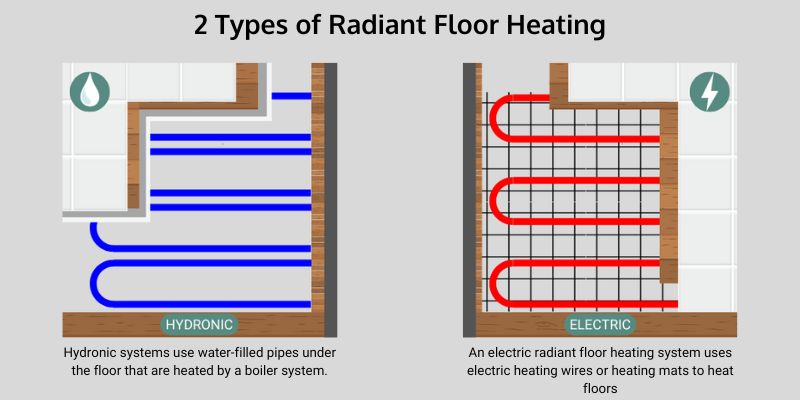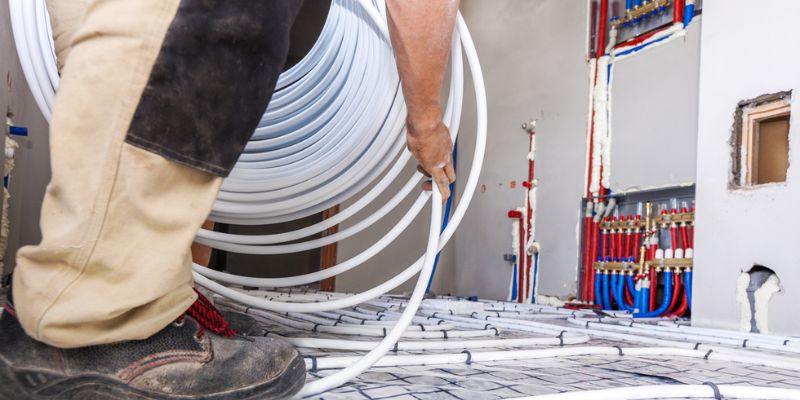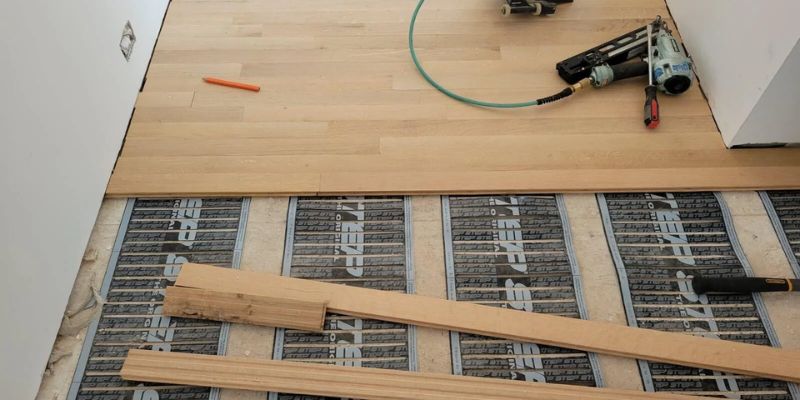Key Summary
- Electric and water underfloor heating systems differ in energy source, installation complexity, and cost, with electric being more accessible and easier to install, but potentially less efficient than water systems.
- Various installation methods exist for both systems, including wet and dry installations, low-profile, suspended floor, in-screed cable, and overlay systems, catering to different building and renovation requirements.
- When it comes to a winner between electric vs water underfloor heating, electric underfloor heating offers lower upfront costs. Water systems, however, despite higher installation costs, can be more cost-effective in the long run. Ultimately it is dependent on your specific needs and budget.
Electric and Water Heating | What Are They?
When it comes to underfloor radiant heating, understanding the working principles of both electric and water systems is crucial to making an informed choice.
Hydronic systems use water-filled pipes and have an extensive installation process, making them better for new construction or major renovations. In contrast, electric systems use wires or mats and are easier to install, making them good for retrofitting existing homes or smaller areas.

How does Electric Underfloor Heating Work?
Often termed as a “dry” system, electric underfloor heating works by running electricity through heating wires installed beneath your floor. The electricity heats these wires, which in turn radiates warmth upwards, heating your floor and, ultimately, your room. Electric systems are highly efficient, transforming virtually all the electricity they consume into heat.
How does Water Underfloor Heating Work?
Alternatively known as a “wet” system, water underfloor heating circulates warm water through a series of pipes laid under the floor. This water is heated by a boiler or a heat pump, and its warmth is then transmitted to the floor above, which disperses it evenly throughout the room.
Energy Source
Electric underfloor heating systems operate via heating cables or mats that are installed beneath the floor. The energy source, electricity, makes this option versatile, easily accessible, and adaptable, given that nearly every home is equipped with an electrical supply.
On the other hand, water-based underfloor heating, often termed ‘hydronic’, requires a heat source such as a boiler or a heat pump. The water is heated by this source and circulated through a network of pipes laid beneath the floor, radiating warmth upward and into the room.
Electric Underfloor Heating
- Highly versatile and accessible
- Requires no additional equipment like boilers or heat pumps
- Dependent on the price of electricity which may vary
- Less efficient than water underfloor heating
Water Underfloor Heating
- Extremely efficient as water retains heat well
- Can be paired with energy-efficient boilers or heat pumps
- Requires a heat source
- Not as easily accessible as electric underfloor heating
Installation
The ease of installation is a notable advantage of electric underfloor heating systems. The elements are thin, requiring minimal alteration to existing floor levels, and can be rolled out directly onto the subfloor or insulation, making it an ideal option for retrofitting in an existing space.
Water-based systems necessitate a more elaborate installation process. The network of pipes required for a hydronic system often means alterations to the existing floor structure. This could involve raising the floor height to accommodate the pipework and may require adjustments to doorways and fixtures, adding complexity and time to the installation.
Electric Underfloor Heating
- Simple installation process
- Minimal alterations to floor levels
- Ideal for retrofitting in existing spaces
- Typically only suitable for smaller areas due to higher running costs
- Potential need for a dedicated circuit for larger installations
Water Underfloor Heating
- Suitable for larger areas or whole-house heating
- Can be integrated with the central heating system
- Complex installation that often needs significant alterations to floor structure
- May require adjustments to doorways and fixtures
Cost

The radiant floor heatingd running costs are quite varied. Electric underfloor heating systems are typically less expensive, largely due to the less complex installation process. The cost for the heating elements themselves is also generally more economical, however, the operational costs can vary significantly depending on several factors such as insulation efficiency, room size, how often the system is in use, and local electricity tariffs.
In contrast, while water systems can incur higher upfront costs due to more complex installation requirements and more expensive materials, they can be more cost-effective in the long term. These systems often integrate with highly efficient boilers or heat pumps, and the cost of operation can be significantly lower, especially in well-insulated properties.
Electric Underfloor Heating
- Lower upfront costs due to less complex installation
- More economical heating elements
- Operational costs can vary significantly
Water Underfloor Heating
- More cost-effective in the long term
- Often integrates with highly efficient boilers or heat pumps
- Higher upfront costs
Heat Distribution
When considering heat distribution, water underfloor heating systems excel. The heat emitted from the network of water pipes provides uniform warmth across the entire floor surface, ensuring a consistent temperature throughout the room.
Electric systems, while also effective at heating, may exhibit slight variations in temperature. This is due to the placement of electric underfloor heat mats or heating cables which can result in marginally cooler spots between the heating elements, however, when installed correctly and evenly, these variations are minimal and often imperceptible.
Electric Underfloor Heating
- Effective at heating
- Quick heat-up times
- May exhibit slight variations
Water Underfloor Heating
- provides uniform warmth across the entire floor surface
- Heat lasts longer after the system is turned off due
- Heat-up time can be longer as the heat has to move through a layer of screed before reaching the floor surface.
Electric vs Water Heating | Summary
| Aspect | Electric Heating | Water Heating |
|---|---|---|
| Energy Source | Electricity | Boiler or Heat Pump |
| Installation Complexity | Less Complex | More Complex |
| Upfront Cost | Lower | Higher |
| Operating Cost | Varies | Varies |
| Heat Distribution | Slight Variations | Uniform |
Electric vs Water Underfloor Heating Installation Process

Electric underfloor heating systems are generally easier to install. These systems are flexible and can be shaped to fit any room layout, and they don’t require extensive alterations to the existing floor structure.
Water-based systems, on the other hand, require a more complicated installation process. The pipes must be integrated into the floor structure, which often requires raising the floor level. As such, these systems are better suited to new builds or substantial renovation projects, however, with careful planning and execution, it is possible to install water underfloor heating in virtually any property.
Heating Installation Methods
Wet Installation
This method involves embedding the underfloor heating system into a wet screed. This is a common method for water-based systems, but it can also be used for electric systems.
Dry Installation
In this method, the heating system is installed within an insulated panel, eliminating the need for screeding. This method is often used for electric underfloor heating systems.
Low-profile Systems
These are ultra-thin electric or slimline water systems designed to minimize floor height increase, ideal for retrofit projects but may offer lower heat output.
Suspended Floor Systems
This method involves installing the heating system between the joists of suspended timber floors from below, suitable for both electric and water systems, with insulation placed beneath.
In-screed Cable Systems
Specific to electric heating, this method involves laying heating cables onto the insulation layer and covering with screed, offering a customizable layout but requiring longer installation and drying times.
Overlay Systems
These are pre-routed panels installed above the existing floor where heating cables or water pipes are laid, offering a quick, easy solution with minimal height increase, suitable for renovations and new builds.
Installation Costs of Electric vs Water Underfloor Heating
The average installation cost for electric underfloor heating ranges from $6 to $10 per square foot, including both materials and labor. Water-based systems tend to be more expensive, with an average cost of $10 to $15 per square foot.
Electric vs Water Underfloor Heating Typical Costs | Summary
| Cost Factor | Electric Heating | Water Heating |
|---|---|---|
| Materials Cost | $3 – $5 per square foot | $6 – $9 per square foot |
| Labor Cost | $3 – $5 per square foot | $4 – $6 per square foot |
| Maintenance Cost | $50 – $100 per year | $100 – $200 per year |
| Energy Cost | $0.10 – $0.20 per kWh (depending on local rates) | $1 – $2 per therm (depending on system efficiency) |
Is Electric or Water Underfloor Heating Cheaper?
While the initial installation cost of running an electric underfloor heating system can be lower than that of a water-based system, it’s important to consider the long-term running costs.
Water-based systems can be more energy-efficient, leading to lower operating costs over time. This is especially true if your home has a highly efficient boiler or heat pump, good insulation, and you use the system continuously.
Installation Times for Electric and Water Underfloor Heating
The time taken to install an underfloor heating system largely depends on the type of system and the size of the area to be heated. As a rule of thumb, electric systems can be installed more quickly due to their less complicated installation process. Depending on the project’s scale, installation can take anywhere from a few hours to a few days.
On the other hand, installing a water-based system is more time-consuming and can take several days or even a week, depending on the project’s complexity and size.
Frequently Asked Questions
Is water underfloor heating better than electric?
Choosing underfloor heating, electric or water, ultimately depends on your specific needs which is why it is difficult to say which type of underfloor heating is best, as it is a personal choice. If you’re seeking a more evenly distributed heat, or if you have an efficient heat source such as a modern boiler or heat pump, a water system might be preferable, however, if you’re looking for a system that’s easier and quicker to install, especially in a retrofit scenario, an electric system could be the better choice.
What is wet electric heating?
“Wet electric heating” is a term that can cause some confusion as it’s a bit of a misnomer. There’s no such thing as “wet electric heating” – what people often mean by this term is “wet underfloor heating,” which refers to water-based underfloor heating systems.
Conclusion
Choosing between electric and water underfloor heating depends on several factors, including your energy source, installation complexity, cost considerations, and preferred heat distribution.
While electric underfloor heating offers versatility, ease of installation, and lower upfront costs, water underfloor heating provides uniform heat distribution and can offer lower long-term operating costs. In the end, your choice should align with your specific requirements, preferences, and budget.





